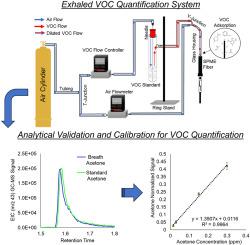当前位置:
X-MOL 学术
›
Anal. Chim. Acta
›
论文详情
Our official English website, www.x-mol.net, welcomes your feedback! (Note: you will need to create a separate account there.)
Quantifying exhaled acetone and isoprene through solid phase microextraction and gas chromatography-mass spectrometry
Analytica Chimica Acta ( IF 6.2 ) Pub Date : 2024-03-12 , DOI: 10.1016/j.aca.2024.342468 Eray Schulz , Mark Woollam , Sneha Vashistha , Mangilal Agarwal
Analytica Chimica Acta ( IF 6.2 ) Pub Date : 2024-03-12 , DOI: 10.1016/j.aca.2024.342468 Eray Schulz , Mark Woollam , Sneha Vashistha , Mangilal Agarwal

|
Acetone, isoprene, and other volatile organic compounds (VOCs) in exhaled breath have been shown to be biomarkers for many medical conditions. Researchers use different techniques for VOC detection, including solid phase microextraction (SPME), to preconcentrate volatile analytes prior to instrumental analysis by gas chromatography-mass spectrometry (GC-MS). These techniques include a previously developed method to detect VOCs in breath directly using SPME, but it is uncommon for studies to quantify exhaled volatiles because it can be time consuming due to the need of many external/internal standards, and there is no standardized or widely accepted method. The objective of this study was to develop an accessible method to quantify acetone and isoprene in breath by SPME GC-MS. A system was developed to mimic human exhalation and expose VOCs to a SPME fiber in the gas phase at known concentrations. VOCs were bubbled/diluted with dry air at a fixed flow rate, duration, and volume that was comparable to a previously developed breath sampling method. Identification of acetone and isoprene through GC-MS was verified using standards and observing overlaps in chromatographic retention/mass spectral fragmentation. Calibration curves were developed for these two analytes, which showed a high degree of linear correlation. Acetone and isoprene displayed limits of detection/quantification equal to 12 ppb/37 ppb and 73 ppb/222 ppb respectively. Quantification results in healthy breath samples (n = 15) showed acetone concentrations spanned between 71 ppb and 294 ppb, and isoprene varied between 170 ppb and 990 ppb. Both concentration ranges for acetone and isoprene in this study overlap with those reported in existing literature. Results indicate the development of a system to quantify acetone and isoprene in breath that can be adapted to diverse sampling methods and instrumental analyses beyond SPME GC-MS.
中文翻译:

通过固相微萃取和气相色谱-质谱法定量呼出的丙酮和异戊二烯
呼出气中的丙酮、异戊二烯和其他挥发性有机化合物 (VOC) 已被证明是许多医疗状况的生物标志物。研究人员使用不同的 VOC 检测技术,包括固相微萃取 (SPME),在气相色谱-质谱 (GC-MS) 进行仪器分析之前预浓缩挥发性分析物。这些技术包括先前开发的使用 SPME 直接检测呼吸中 VOC 的方法,但量化呼出挥发物的研究并不常见,因为由于需要许多外部/内部标准,这可能非常耗时,并且没有标准化或广泛的标准接受的方法。本研究的目的是开发一种通过 SPME GC-MS 定量呼吸中丙酮和异戊二烯的简便方法。开发了一种系统来模拟人类呼气并将 VOC 以已知浓度暴露在气相 SPME 纤维中。 VOC 以固定的流速、持续时间和体积用干燥空气鼓泡/稀释,与之前开发的呼吸采样方法相当。使用标准品并观察色谱保留/质谱碎片的重叠,验证了通过 GC-MS 对丙酮和异戊二烯的鉴定。为这两种分析物开发了校准曲线,显示出高度的线性相关性。丙酮和异戊二烯的检测/定量限分别为 12 ppb/37 ppb 和 73 ppb/222 ppb。健康呼吸样本 (n = 15) 的定量结果显示,丙酮浓度在 71 ppb 到 294 ppb 之间,异戊二烯浓度在 170 ppb 到 990 ppb 之间变化。本研究中丙酮和异戊二烯的浓度范围与现有文献中报道的浓度范围重叠。结果表明,我们开发了一种定量呼吸中丙酮和异戊二烯的系统,该系统可以适应除 SPME GC-MS 之外的多种采样方法和仪器分析。
更新日期:2024-03-12
中文翻译:

通过固相微萃取和气相色谱-质谱法定量呼出的丙酮和异戊二烯
呼出气中的丙酮、异戊二烯和其他挥发性有机化合物 (VOC) 已被证明是许多医疗状况的生物标志物。研究人员使用不同的 VOC 检测技术,包括固相微萃取 (SPME),在气相色谱-质谱 (GC-MS) 进行仪器分析之前预浓缩挥发性分析物。这些技术包括先前开发的使用 SPME 直接检测呼吸中 VOC 的方法,但量化呼出挥发物的研究并不常见,因为由于需要许多外部/内部标准,这可能非常耗时,并且没有标准化或广泛的标准接受的方法。本研究的目的是开发一种通过 SPME GC-MS 定量呼吸中丙酮和异戊二烯的简便方法。开发了一种系统来模拟人类呼气并将 VOC 以已知浓度暴露在气相 SPME 纤维中。 VOC 以固定的流速、持续时间和体积用干燥空气鼓泡/稀释,与之前开发的呼吸采样方法相当。使用标准品并观察色谱保留/质谱碎片的重叠,验证了通过 GC-MS 对丙酮和异戊二烯的鉴定。为这两种分析物开发了校准曲线,显示出高度的线性相关性。丙酮和异戊二烯的检测/定量限分别为 12 ppb/37 ppb 和 73 ppb/222 ppb。健康呼吸样本 (n = 15) 的定量结果显示,丙酮浓度在 71 ppb 到 294 ppb 之间,异戊二烯浓度在 170 ppb 到 990 ppb 之间变化。本研究中丙酮和异戊二烯的浓度范围与现有文献中报道的浓度范围重叠。结果表明,我们开发了一种定量呼吸中丙酮和异戊二烯的系统,该系统可以适应除 SPME GC-MS 之外的多种采样方法和仪器分析。



























 京公网安备 11010802027423号
京公网安备 11010802027423号